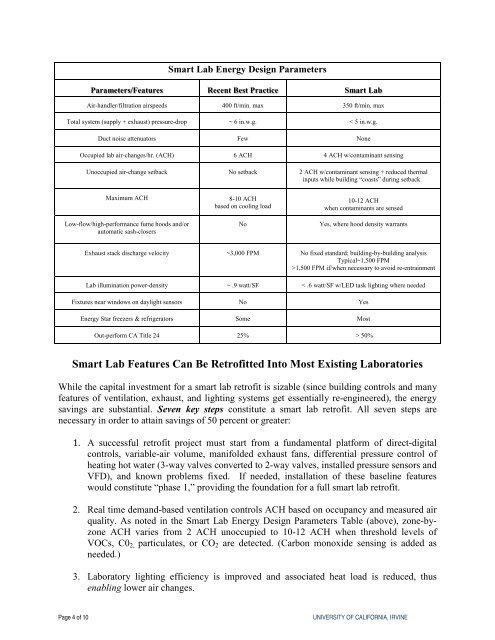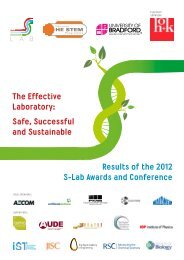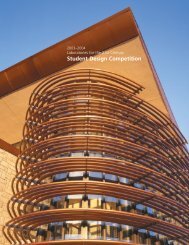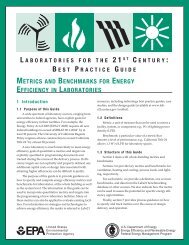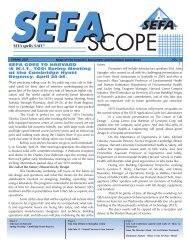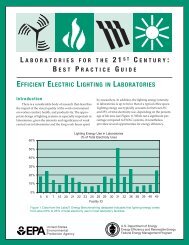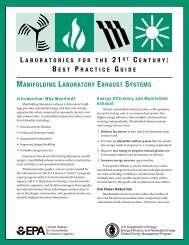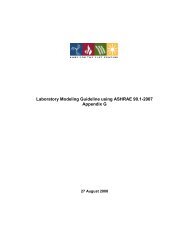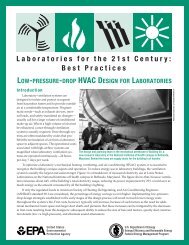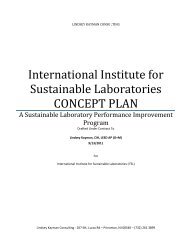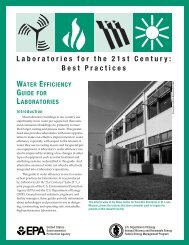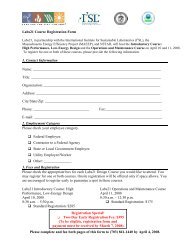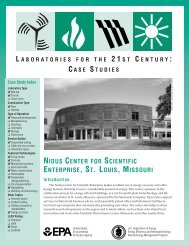Smart Laboratories Cut Energy Consumption More Than Half - I2SL
Smart Laboratories Cut Energy Consumption More Than Half - I2SL
Smart Laboratories Cut Energy Consumption More Than Half - I2SL
Create successful ePaper yourself
Turn your PDF publications into a flip-book with our unique Google optimized e-Paper software.
Parameters/Features<br />
<strong>Smart</strong> Lab <strong>Energy</strong> Design Parameters<br />
Recent Best Practice<br />
<strong>Smart</strong> Lab<br />
Air-handler/filtration airspeeds 400 ft/min. max 350 ft/min. max<br />
Total system (supply + exhaust) pressure-drop ~ 6 in.w.g. < 5 in.w.g.<br />
Duct noise attenuators Few None<br />
Occupied lab air-changes/hr. (ACH) 6 ACH 4 ACH w/contaminant sensing<br />
Unoccupied air-change setback No setback 2 ACH w/contaminant sensing + reduced thermal<br />
inputs while building “coasts” during setback<br />
Maximum ACH<br />
Low-flow/high-performance fume hoods and/or<br />
automatic sash-closers<br />
8-10 ACH<br />
based on cooling load<br />
No<br />
10-12 ACH<br />
when contaminants are sensed<br />
Yes, where hood density warrants<br />
Exhaust stack discharge velocity ~3,000 FPM No fixed standard; building-by-building analysis<br />
Typical~1,500 FPM<br />
>1,500 FPM if/when necessary to avoid re-entrainment<br />
Lab illumination power-density ~ .9 watt/SF < .6 watt/SF w/LED task lighting where needed<br />
Fixtures near windows on daylight sensors No Yes<br />
<strong>Energy</strong> Star freezers & refrigerators Some Most<br />
Out-perform CA Title 24 25% > 50%<br />
<strong>Smart</strong> Lab Features Can Be Retrofitted Into Most Existing <strong>Laboratories</strong><br />
While the capital investment for a smart lab retrofit is sizable (since building controls and many<br />
features of ventilation, exhaust, and lighting systems get essentially re-engineered), the energy<br />
savings are substantial. Seven key steps constitute a smart lab retrofit. All seven steps are<br />
necessary in order to attain savings of 50 percent or greater:<br />
1. A successful retrofit project must start from a fundamental platform of direct-digital<br />
controls, variable-air volume, manifolded exhaust fans, differential pressure control of<br />
heating hot water (3-way valves converted to 2-way valves, installed pressure sensors and<br />
VFD), and known problems fixed. If needed, installation of these baseline features<br />
would constitute “phase 1,” providing the foundation for a full smart lab retrofit.<br />
2. Real time demand-based ventilation controls ACH based on occupancy and measured air<br />
quality. As noted in the <strong>Smart</strong> Lab <strong>Energy</strong> Design Parameters Table (above), zone-byzone<br />
ACH varies from 2 ACH unoccupied to 10-12 ACH when threshold levels of<br />
VOCs, C0 2, particulates, or CO 2 are detected. (Carbon monoxide sensing is added as<br />
needed.)<br />
3. Laboratory lighting efficiency is improved and associated heat load is reduced, thus<br />
enabling lower air changes.<br />
Page 4 of 10<br />
UNIVERSITY OF CALIFORNIA, IRVINE


